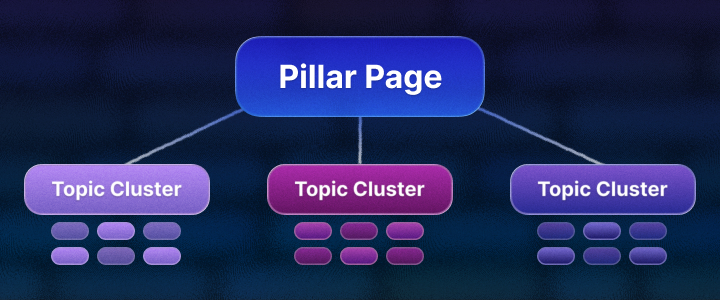Mastering SEO for Copilot: Practical Steps to Boost Your Rankings
AI tools are transforming how people search, and the required SEO for Copilot is evolving in response. Instead of clicking through links, users now get direct, AI-generated answers that synthesize information from multiple sources. If your content isn’t optimized for this shift, you’re missing out on visibility in one of the fastest-growing search channels.
This guide will show you exactly how to optimize your content for Copilot, from technical markup to content structure, so you can increase your chances of being featured in AI-generated answers and grow your AI search visibility.
Key Takeaways
- Structure content for AI extraction – Use schema markup, semantic HTML, and topic clusters to help Copilot easily identify and retrieve relevant information from your pages.
- Optimize for direct answers – Write concise 30-60 word paragraphs with clear headings and bullet points that AI can quickly extract and cite in responses.
- Build credibility with E-E-A-T – Establish expertise through detailed guides, earn authoritative backlinks, and demonstrate trustworthiness to increase your chances of being cited by Copilot.
- Prioritize technical SEO and tracking – Ensure fast page speeds, mobile optimization, and proper indexing, then use analytics tools to monitor how Copilot cites and drives traffic to your content.
Understanding Microsoft Copilot
Microsoft Copilot is an AI assistant integrated across Bing search, Windows 11, and Microsoft 365 applications. Unlike traditional search engines that return a list of links, Copilot synthesizes information to provide direct, conversational answers to user queries.
How Copilot Works
Copilot combines two key technologies:
- Bing’s search index – Accesses and retrieves relevant content from billions of web pages in real-time
- Large language models (GPT-4) – Understands natural language queries, interprets context and nuance, and generates human-like responses
When a user asks a question, Copilot:
- Analyzes the query to understand user intent
- Searches Bing’s index for the most relevant web pages
- Extracts and synthesizes key information from multiple sources
- Generates a comprehensive answer in conversational language
- Cites sources so users can verify information
This approach means users get immediate answers without clicking through multiple websites. For content creators, this shift is crucial: your content needs to be easily discoverable, well-structured, and contain clear information that Copilot can extract and include in its responses.
Structuring Content for Copilot
Effective content structuring is essential for ensuring that Microsoft’s AI can interpret and retrieve relevant information efficiently. One of the most effective strategies for structuring content is the use of topic clusters.
A topic cluster is a network of interconnected content organized around a central pillar page, which covers a broad topic comprehensively. This approach not only enhances user engagement by providing related information easily but also improves SEO effectiveness by establishing a clear content hierarchy.

Creating a pillar page alongside cluster pages helps improve search engine rankings and visibility:
- The pillar page acts as the main hub of information.
- The cluster pages delve into specific subtopics.
- All pages are interlinked to provide a coherent and comprehensive resource for users.
- This structured approach makes it easier for search engines like Bing to index and rank your content.
Additionally, technical SEO practices are crucial for improving content visibility. Focusing on aspects such as site speed, mobile optimization, and structured data enhances your website’s performance and accessibility to search engines.
Utilizing Schema Markup and Semantic HTML
Schema markup and semantic HTML are powerful tools for enhancing content visibility and understanding by search engines. Using the correct schema markup, such as JSON-LD, provides clear definitions of data to search engines, helping them interpret the content more accurately. This improved understanding can lead to better indexing and higher search rankings.
Semantic HTML elements, such as h1, h2, section, and article, contribute to better clarity and context for search engines. These elements improve the accessibility of your content and help search engine algorithms understand the structure and relevance of your pages. By adopting these practices, you can enhance your search engine optimization efforts and improve your content’s visibility.
Creating Mobile-Friendly and Fast-Loading Pages
Mobile optimization and fast loading times are critical factors in search engine optimization. With a significant portion of web traffic coming from mobile devices, it’s essential to ensure that your pages are optimized for mobile users. This not only improves user experience but also impacts your Core Web Vitals scores, which are crucial for search rankings.
One effective technique for improving page speed is optimizing images and code. This includes:
- Compressing images to reduce file size
- Minimizing code to decrease loading times
- Implementing lazy loading techniques for images and videos to further improve page speed and performance
These steps help ensure a smooth and fast user experience by enhancing overall website performance.
Enhancing Content Credibility with E-E-A-T
Enhancing content credibility is essential for improving search engine rankings, and the E-E-A-T framework (Experience, Expertise, Authoritativeness, and Trustworthiness) plays a crucial role in this process. By focusing on these four pillars, you can create rank content that is not only relevant and informative but also trusted and authoritative.

Clear and well-structured code is one way to increase the chances of your website being recognized as a trusted source. Ensuring that your content is well-organized and easy to navigate helps build trust with both users and search engines. This trustworthiness is further reinforced by the quality of the information you provide and the expertise you demonstrate in your content.
Building authoritative backlinks is another key strategy for enhancing content credibility. High-quality backlinks from credible sites serve as strong indicators of your site’s authority. Earning backlinks through guest posting, original research, and updating outdated resources enhances your site’s visibility and ranking potential.
Building Authoritative Backlinks
Earning high-quality backlinks is a critical aspect of search engine optimization. One effective strategy is to provide valuable input to reporters and a blog post through platforms that facilitate connections. Offering unique insights and valuable content helps earn backlinks from credible sources, enhancing your site’s authority.
Another approach is to create new content types that attract passive mentions, such as:
- Original data
- Infographics
- Free tools
These types of content generation are more likely to be cited by other websites, increasing your visibility and credibility. Additionally:
- Updating outdated resources
- Suggesting your brand in place of those resources can provide opportunities for earning backlinks.
Showcasing Expertise Through Detailed Guides
Developing comprehensive guides is an effective way to showcase your expertise and enhance your site’s credibility. These guides should address user queries in detail, providing valuable information that positions your brand as an authority in your niche. This significantly enhances perceived expertise and attracts high-authority backlinks.
Including original research, case studies, and practical Example in your guides can further solidify your authority on a subject. This not only boosts your credibility but also increases the potential for citations and higher search rankings.
Establishing authority through well-crafted guides creates a strong foundation for improved trustworthiness and SEO performance.
Optimizing Content for Direct Answers
Optimizing content for direct answers is crucial in the age of AI-driven search engines like Microsoft Copilot. These AI tools prioritize content that directly addresses user queries, making it essential to design your content with user intent in mind. By structuring your content to match user intent clearly, you can enhance its relevance and increase the likelihood of being selected as a direct answer.
To achieve this, your content should:
- Be designed to address specific user queries clearly and directly.
- Include concise, answer-ready paragraphs that provide users with key information without unnecessary details.
- Have a clear structure that allows AI systems to determine the relevant information easily.
Using topic clusters is another effective strategy for optimizing content for diverse search queries. By targeting both short-tail and long-tail target keywords, you can ensure that your content is optimized for a range of user intents. This structured approach not only improves the relevance of your content but also enhances its visibility in search results.
Writing Concise Answer-Ready Paragraphs
Writing concise, answer-ready paragraphs is key to being selected as a direct answer. These paragraphs should focus on delivering the key information in a clear and direct manner, without unnecessary details. The ideal length for answer-ready paragraphs is 30 to 60 words, which ensures clarity and brevity. To write effectively, one must prioritize clarity.
Using simple and direct language increases the likelihood that your content will be selected as a direct answer. By structuring your paragraphs concisely, you make it easier for AI to extract the relevant information quickly, enhancing your content’s visibility and effectiveness.
Using Bullet Points and Clear Headings
Incorporating bullet points and clear headings into your content significantly improves readability and retrieval efficiency. Benefits include:
- Clear headings summarize the content efficiently, guiding both AI and human readers through the text, providing key takeaways.
- Helps users quickly grasp the main points.
- Ensures that search engines can accurately understand and index the content.
Bullet points make the content more scannable, which is beneficial for both users and AI. Ideally, bullet lists should contain 3 to 7 tips, making them easy to comprehend and retrieve.
By using these formatting techniques, you enhance the overall user experience and improve your content’s chances of being selected as a direct answer in search results.
Leveraging Internal Linking and Topic Clusters
Leveraging internal linking and organizing content into topic clusters are effective strategies for enhancing SEO and user engagement. Internal linking:
- Enhances navigation for users
- Helps search engines understand the structure of your website
- Creates a network of interconnected pages that support each other, improving overall site authority.

Organizing content into topic clusters involves creating a pillar page that covers a broad topic comprehensively and several cluster pages that delve into specific subtopics. This approach not only improves user experience by providing a structured way to find related information but also enhances your content’s visibility in search results. Regularly publishing fresh content within these clusters helps maintain visibility and relevance.
Focusing on relevant keywords and ensuring well-organized content improves your SEO efforts and increases organic traffic. This structured approach makes it easier for search engines to index and rank your focused content, ultimately boosting your search rankings.
Developing Strong Internal Links
Developing strong internal links is essential for supporting content discoverability and user engagement. Internal links enhance navigation for users, making it easier for them to find relevant content on your site. These links also help search engines understand the structure of your website, improving indexing and ranking potential.
Effective internal linking involves using strategic anchor texts that enhance SEO and contextual relevance. Regularly auditing your internal links ensures that they point to the most relevant and valuable content, distributing page authority across your site and reducing bounce rates.
Organizing Content into Topic Clusters
Organizing content into topic clusters is an effective strategy for enhancing relevance in search results. Consistently publishing fresh content within these clusters maintains visibility and relevance, positioning your content favorably in search engines. This marketing approach helps you target both short-tail and long-tail keywords, improving your content’s reach and effectiveness.
Regularly analyzing content publishing strategies from competitors can provide valuable insights into effective publishing strategies. By benchmarking your content velocity against these insights, you can refine your SEO planning and improve your content’s performance.
Technical SEO for Discovery
Technical SEO is crucial for ensuring that your content is easily discoverable by Microsoft Copilot. Structured data provides signals about content purpose and format, helping Copilot retrieve relevant information efficiently. Ensuring that your content is well-structured for AI understanding and retrieval is essential for being cited by Copilot.
Fast-loading pages are another critical factor in technical SEO. Slow-loading pages may be skipped by Copilot in favor of faster alternatives, impacting your content’s visibility. Good Core Web Vitals, mobile-friendly design, and clear layout are essential for creating fast-loading, optimized pages.
Bing prioritizes mobile experiences over desktop, making a mobile-friendly design crucial for ranking well with Copilot. By focusing on technical SEO practices, you can enhance your content’s visibility and ensure that it is easily discoverable by Copilot and other AI-driven search engines.
Ensuring Crawlability and Proper Indexing
Ensuring crawlability and proper indexing is fundamental to effective SEO. Key components include:
- A clear site structure with an organized hierarchy to aid search engines in effectively crawling and indexing web pages.
- Implementing XML sitemaps.
- Optimizing site structure to ensure proper indexing in SERPs.
Using Bing Webmaster Tools helps website owners identify and fix crawl issues that can impede indexing. Regularly auditing internal links ensures that authority is effectively distributed among important pages on the site, improving the ranking potential for linked pages.
Optimizing Core Web Vitals
Optimizing Core Web Vitals is essential for enhancing user experience and search rankings. Core Web Vitals measure aspects of user experience, including loading speed, interactivity, and visual stability. Improving these metrics can lead to higher search engine rankings due to better user engagement.
Improving Core Web Vitals involves optimizing images and reducing server response times to enhance overall site speed. Focusing on these metrics ensures a better user experience and improves your content’s visibility in search results.
Tracking and Analyzing Copilot Performance
Tracking and analyzing the performance of your content in Copilot is crucial for understanding its effectiveness. Analyzing patterns from log files with AI assistance can help prioritize crawl-related issues and improve overall SEO performance. Leveraging these insights helps refine your SEO strategies and enhance your content’s performance.
Monitoring mentions of your content in Copilot can be challenging, but there are numerous analytics tools that simplify the process. These tools help track AI mentions, citations, and sentiment metrics, providing valuable insights into your content’s engagement levels. Understanding which AI models are driving traffic to your website allows for targeted optimization efforts based on performance metrics.
Analyzing traffic and engagement metrics from Copilot can reveal how well your content captures user interest and retains attention. By leveraging these insights, you can refine your content strategies to enhance effectiveness and reach your target audience more effectively.
Monitoring Copilot Mentions
Tracking mentions of your content in Copilot can be challenging due to the unpredictable nature of prompts generated by the system. However, tools like ZipTie and Trakkr, and many others, provide insights into AI mentions, citations, and sentiment metrics. These tools make it easier for businesses to evaluate their engagement levels and understand which AI models are driving traffic to their websites.
AthenaHQ tracks brand mentions across major LLMs, offering detailed prompt analytics and insights into the competitive landscape in AI search. Using these tools allows you to monitor your content’s performance in Copilot and refine your SEO strategies accordingly.
Analyzing Traffic and Engagement Metrics
Analyzing traffic and engagement metrics from Copilot provides valuable insights into how effectively your content is reaching users. Metrics derived from Copilot-driven traffic can illuminate user engagement and content interaction levels, helping you understand how well your content captures user interest and retains attention.
By leveraging these insights, you can refine your content strategies to enhance effectiveness and reach your target audience more effectively. Understanding user interactions and engagement metrics allows for better optimization of content, ultimately improving your search engine rankings and overall SEO performance.

Summary
Mastering SEO for Microsoft Copilot requires a multifaceted approach that includes structuring your content effectively, enhancing its credibility, optimizing it for direct answers, leveraging internal linking and topic clusters, and ensuring robust technical SEO practices. By understanding how Microsoft Copilot functions and integrating these strategies into your SEO efforts, you can significantly boost your search rankings and ensure your content stands out in the AI-driven search landscape.
In conclusion, the key to success lies in staying ahead of the curve and continuously refining your strategies based on performance insights. By implementing the practical steps outlined in this guide, you’ll be well-equipped to navigate the evolving world of AI-driven SEO and achieve greater visibility and engagement for your content.
Frequently Asked Questions
What is Microsoft Copilot?
Microsoft Copilot is an AI-driven assistant embedded in Bing, Windows 11, and Microsoft 365, designed to offer context-aware support and comprehensive responses to user inquiries directly, streamlining information access.
How does Copilot use Bing and GPT-4?
Copilot leverages Bing’s comprehensive web indexing alongside GPT-4’s sophisticated natural language processing capabilities to provide users with relevant and contextually aware responses. This integration enhances the overall user experience by delivering precise information efficiently.
What is the E-E-A-T framework?
The E-E-A-T framework, which stands for Experience, Expertise, Authoritativeness, and Trustworthiness, is essential for boosting content credibility and optimizing search engine rankings. Prioritizing these elements ensures your content is reliable and valuable to readers.
How can I optimize my content for direct answers?
To effectively optimize your content for direct answers, ensure that your text is concise and clearly addresses specific user queries, utilizing bullet points and headings for enhanced readability. This approach will improve the chances of your content being recognized as authoritative and relevant in search results.
What tools can I use to monitor Copilot mentions?
You can use tools such as ZipTie, Trakkr, and AthenaHQ to effectively monitor Copilot mentions, track citations, and analyze sentiment metrics for valuable insights.

